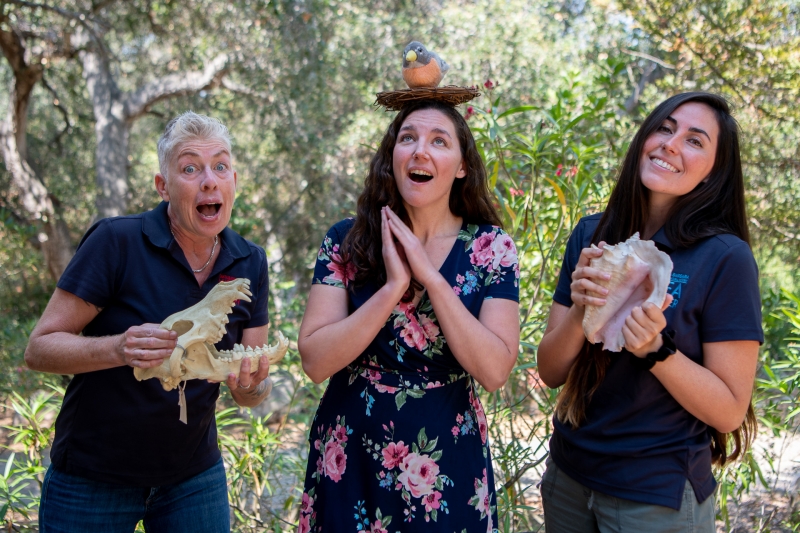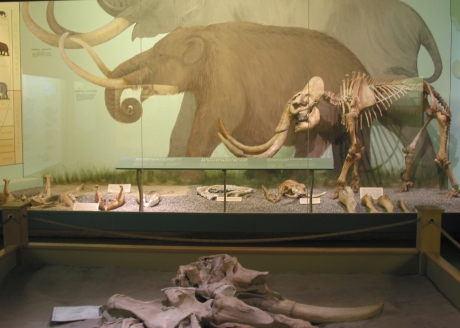Live Virtual Field Trips
Wherever you are, our team is ready to take your class on an educational journey!
Registration for fall 2022 field trips is now open
Booking for winter and spring 2023 will open on November 2, 2022.
We offer a wide variety of NGSS-aligned, live, interactive, kid-centered virtual field trips for grades K–12. We bring kids to the Museum through the magic of Zoom, and from there, we are able to go further than they could ever go at any “real” Museum. We visit the deepest parts of the ocean to visit the “aliens” that live right here on Earth, go billions of years back in the past to see the Earth being born, and head out to the Channel Islands to visit the rare and unique animals that make their homes there.

Check out details for each of our grade-specific programs:
Kindergarten-aligned, grades K–2 appropriate
Water Bear Don’t Care! How Animals Adapt to Live in Your Backyard and in Some of the Wildest Places on Earth
We’ll visit some familiar and beloved animals to learn how they are adapted to their environments, the foods they eat, and the challenges they face in their daily lives. Then we’ll visit some amazing animals that live in the strangest places on Earth, to see how they have grown and changed to fit just right where they belong.
This field trip is aligned with NGSS standards 2-LS4-1 (Biological Evolution: Unity and Diversity) and K (Interdependent Relationships in Ecosystems: Animals, Plants, and Their Environment).
1st grade-aligned, grades K–2 appropriate
Cuteness Overload! Baby Animals and Their Parents
We look at the life cycles of different animals, observing the traits they may share with their parents and the traits that make them unique. Students learn about the different ways animals grow and survive, with or without their parents’ help. Students get hands-on experience helping a bird build its nest before their baby bird hatches.
This field trip is aligned with NGSS standards 1-LS1-2 (Read texts and use media to determine patterns in behavior of parents and offspring that help offspring survive) and 1-LS3-1 (Make observations to construct an evidence-based account that young plants and animals are like, but not exactly like, their parents).
2nd grade-aligned, grades 2–8 appropriate
The Living Earth, Fast and Slow
We’ll take your class on a trip to the center of the Earth, back in “deep time” to the birth of our home planet, and—after a couple of stops and stories along the way—home again to our own beautiful California shores. Our journey will show us how our Earth and the life that it supports are deeply connected. We’ll talk about ways we can work to keep life and planet in sync for the good of our natural world and our shared future.
This field trip is aligned with NGSS standard 2-ESS1-1 (Use information from several sources to provide evidence that Earth events can occur quickly or slowly).
Fossil Tales
Fossils tell stories, if you know how to listen. Come with us on an adventure that traces life on Earth from the earliest, alien-like plants and animals to the most familiar of our fossil finds, including dinosaurs, ants, and ancient trees. Learn what fossils are, where they come from, and how they are windows across unimaginably long stretches of time that allow us to see how animal and plant species respond to the challenges around them by gradually changing form and function to survive.
This field trip is aligned with NGSS standard 2-LS4-1 (Make observations of plants and animals to compare the diversity of life in different habitats.)
3rd grade-aligned, grades 3–8 appropriate
Connecting with the Chumash
Students will be introduced to the stories of the Indigenous people of Central California and learn how they adapted to their environments and used the plentiful natural resources available to survive and thrive thousands of years ago. Students learn about the science of anthropology and become junior anthropologists themselves by inspecting real historical documents and listening to wax cylinder recordings to understand the process of learning about and appreciating the Indigenous people who still live on this land today.
This field trip is aligned with NGSS standard 3-5-ETS1-1 (Define a simple design problem reflecting a need or a want that includes specified criteria for success and constraints on materials, time, or cost) as well as History-Social Science Standard 3.2 (Students describe the American Indian nations in their local region long ago and in the recent past. Discuss the ways in which physical geography, including climate, influenced how the local Indian nations adapted to their natural environment, e.g., how they obtained food, clothing, tools).
3rd grade-aligned, grades 2–8 appropriate
Life in the Waves
Students will visit the incredible diversity of creatures that live in our local tide pools, both “out there” under the waves at our local beaches and right here in our own Sea Center. We’ll take a close look at the incredible adaptations that make it possible for creatures and plants to survive and thrive in this ever-changing, ultra-challenging marine environment.
This field trip is aligned with NGSS standards 3-LS4-2 (Use evidence to construct an explanation for how the variations in characteristics among individuals of the same species may provide advantages in surviving, finding mates, and reproducing.) and 3-LS4-3 (Construct an argument with evidence that in a particular habitat some organisms can survive well, some survive less well, and some cannot survive at all).
4th grade-aligned, grades 4–8 appropriate
Harnessing the Power of the Earth
How do we get from here to there? How do we power this and that? What’s the deal with renewable vs. non-renewable resources? Students will discover the vast number of ways humans utilize raw materials formed by the Earth over many millennia, and how their choices can affect the health of the planet that gives us astonishing amounts of power.
This field trip is aligned with NGSS standard 4-PS3-2 (Make observations to provide evidence that energy can be transferred from place to place by sound, light, heat, electric currents) and 4-ESS3-1 (Obtain and combine information to describe that energy and fuels are derived from natural resources and their uses affect the environment).
5th grade-aligned, grades 3–8 appropriate
Biodiversity: It’s Our World to Protect
Take a virtual adventure to Santa Cruz Island, exploring the rich history and unique wildlife found nowhere else on Earth. Trek the island and delve deep underwater to learn how protected areas transform and improve ecosystems.
This field trip is aligned with NGSS standard 5-ESS3-1 (Obtain and combine information about ways individual communities use science ideas to protect the Earth’s resources and environment.) and 3-5-ETS1-2 (Generate and compare multiple possible solutions to a problem based on how well each is likely to meet the criteria and constraints of the problem).
Upper middle and high school-aligned, grades 7–12 appropriate
The Invisible Universe: Revealing the Secret Wonders of Space with Multiwavelength Astronomy
Our Astronomy Department will deliver this audio-visual virtual field trip, in which we will discuss and even experience parts of the electromagnetic spectrum. Students will remotely tour our Palmer Observatory, learning the main concepts around the electromagnetism spectrum, and get a firsthand look at how different types of radiation are used by astronomers to uncover the secrets of a vast and distant universe.
MS-PS4-1, 2, and 3 and HS-PS4-3, 4 and 5 (Waves and their applications in technologies for information transfer)
Here’s what teachers are saying about our programs.
“A whole new virtual trip experience that we had for the first time. The live virtual trip was so amazing. Mr. Steve and Ms. Jessica delivered the lessons very interactively, so informative and knowledgeable teachers. Thank you, Santa Barbara Museum of Natural History for making this happen so students from Indonesia could feel the excitement of your program. Going to have you again this October with another incredible journey :)”
--Leonard, third grade teacher (from Central Java, Indonesia)
“Great presentation! Engaging and entertaining–our kids loved it! The quality of the presentation and organization of the content was so much more than I was expecting! They used Zoom features to their maximum potential to make this information exciting for the kids.”
–Angelica, kindergarten/first grade homeschool teacher
“Such a well put together program for fun virtual learning! We are longing for some normalcy and sense of school and this was the perfect solution! They loved it. They thought the whole experience was fun and didn't quite realize all the learning they were doing.”
–Jeanne, second grade teacher
“Once again and same as always, SBMNH and Sea Center staff have knocked it out of the park. Charlotte, your presentation today was awesome, and I'd venture to say it was on the level of performance art! Thank you both so much for hosting my class, and thanks to the Museum Access Fund for making this opportunity possible to our students. The Museum and Sea Center are fortunate to have pros such as you.”
–Conrad, second grade teacher
“Thank you so much for the incredible virtual field trip today. I am already receiving positive feedback from families. You did a fantastic job keeping everyone engaged and interested in the content! The use of breakout rooms to model biodiversity was fantastic! I was very impressed.”
–Jessica, fifth grade teacher



